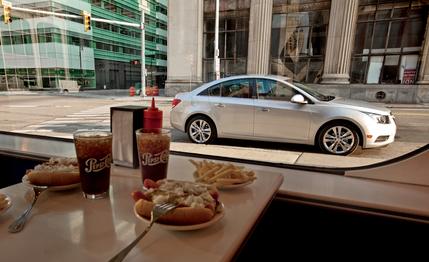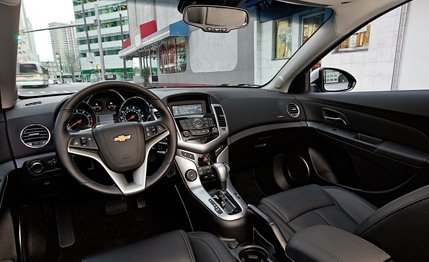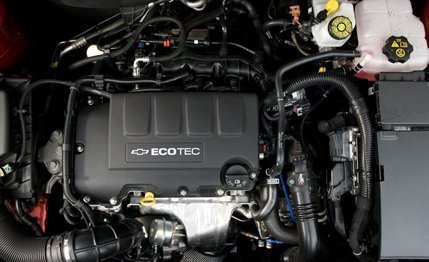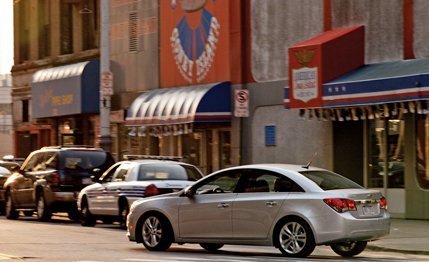 Instrumented Test
Instrumented Test
Since the 1970 debut of the mechanically vermin-infested Vega, GM’s grim experience building econosedans has no doubt been made unhappier by the media, who, upon each debut, ask, “Is this the Great American Small Car?” As the Chevette and an onslaught of Cavaliers would demonstrate, the answer is “no,” has always been “no,” and we all know that it’s “no.” Yet we keep asking, even when the American small car in question is not credibly American—as in the Toyota-built Nova, the Isuzu- and Suzuki-built Geos, and, eventually, every single Saturn sedan, whose tag line, “A different kind of car company,” should have been, “A real familiar kind of car you rented a couple years ago in Europe.”
So, no, we won’t celebrate the Cruze as the Great American Small Car. It can’t be, having been blended by Daewoo in Korea and by Opel in Germany. We will, however, celebrate it for removing from our lives forever the Pontiac G5 and the entry-level Chevy Cobalt—two Ohio-built passenger pigeons that mark a milestone, representing, as they almost certainly do, the last small cars that an all-Yankee GM squad will ever create. Is that a bad thing? Probably not. Is that a sad thing? You bet. Let’s all say it out loud: “America can’t engineer small cars.” See? That wasn’t so hard.
Up close and personal, the Cruze’s styling certainly offends no one. We wish it did. Its nose is a less pugnacious version of the Volt’s, and the rest of the car shyly murmurs, “I’m some sort of intermediate sedan, no need to ask.” The Cruze counts as its enemies the Toyota Corolla, the Hyundai Elantra, the Honda Civic, the Ford Focus, and the Nissan Sentra. Enemies no one needs. No matter how little you spend on your Cruze, you get a lot: 10 airbags, a rollover sensor, pretensioning front belts, stability control, OnStar, XM satellite radio, and power locks and windows.

Driving the Cruze, the first thing you notice is that it’s quiet, an achievement that was no doubt costly. The cabin’s five-layer headliner absorbs racket and simultaneously looks rich. The doors—which slam shut with a rare-for-this-class “ka-thunk”—are triple-sealed. Even the steel fire wall is sandwiched between two damping mats. Our sound-level measurements don’t tell the whole tale here. Yes, the Cruze is quieter at idle than a 2010 Focus SE, quieter at wide-open throttle than a Corolla, and quieter at a 70-mph cruise than a Civic Si. On the other hand, a Kia Forte SX is more hushed at all three. What the Cruze does successfully—to our ears, at least—is take a notable bite out of high-frequency thrash. The most intrusive noise at 70 mph is tire boom.
Although the Cruze’s EPA interior volumes suggest otherwise, the cabin feels narrow. Headroom is certainly ample, but the driver quickly notices that the seat cushion is a little rail-like and that his right leg—from knee to ankle—is often in contact with the center tunnel. Bend your left leg at the knee, and it rubs the window-switch panel.
Cabin surfaces and fit and finish are both best in class, easily matching or exceeding what you’d get in a VW Jetta or a Mazda 3. The vanilla headliner, the glossy-black dash inserts, the faux brushed-aluminum accents, the blue backlit gauges—all are warm, inviting, and expertly grained. The center stack is sensibly organized; there’s a real hand brake between the seats; and the free-floating shade over the instrument nacelle would look fine in a Lexus. In fact, the only nasty surfaces are the squalid black-plastic inserts at the base of the C-pillars, possibly obtained from a DIY recycling center in Zanzibar.
Two adults can lodge themselves happily in the rear, where GM has finally seen fit to raise the cushion so that knees aren’t hoisted to belt-buckle height. Back-seat riders must jam their feet under the front seats, but that’s the only dimension at a premium. A fifth rider? Well, maybe a third-grader.
The base Cruze LS, starting at $16,995, offers a 136-hp, 1.8-liter Ecotec matched to a six-speed manual. Big shots that we are, we leapt straight to the penthouse LTZ ($22,695 base), with six-speed automatic and 138-hp, 1.4-liter turbo Ecotec—still sipping regular fuel. Maybe you noticed: The optional engine delivers two bonus horses and 25 extra pound-feet. Idea for GM: Offer just one powerplant.

Acceleration? Not that we noticed. Despite the hard-working turbo—which you feel and hear only as a subtle quickening at 3000 rpm in first gear—60 mph doesn’t manifest for 8.9 seconds. That’s barely acceptable, given that our eight “$18,000 Mileage Makers” [May 2008] averaged the same feat 0.6 second sooner. Adding to the lethargy is the Hydra-Matic 6T40, which is mapped to grab sixth in a kind of obsessive-compulsive anti-rpm disorder. Big throttle inputs are greeted with those exasperating “you really wanna do this?” waiting-room pauses. There’s no dithering the throttle in the Cruze. Your foot is basically planted eternally, and the engine consequently hangs at busy-buzzy revs, gear after gear, straining until it bangs off the 6500-rpm limiter.
Eventually, the driver realizes it’s his role to predict big accelerative events before they materialize. Fail at that, and it’s Plan B: pounding away at the admittedly quick manumatic. It can wear you down. As we said, much of the thrash never makes it wholly into the cabin, but no four-pot this side of a Cosworth sounds great when it is so relentlessly straining.
The electric steering is ultra low-effort, not inappropriate to parking and city-traffic speeds, and interstate tracking is excellent. The wheel is adjustable for reach and rake. In the hills, though, the steering needs to wait up and weight up. It’s easy to crank in too many degrees at turn-in, requiring an unprofessional midcorner unwind.
Here’s a corker: Despite its Costco torsion-beam rear suspension, the Cruze delivers terrific handling. On the skidpad, the LTZ’s 18-inch Michelins clutched to a 0.85-g fare-thee-well. “It won’t be reflected in real-world handling,” we predicted. Wrong. Our test car nosed down our handling loop like it was looking for Mid-Ohio—flat, poised, confident, zero body float. With so little power on tap, the experience doesn’t exactly summon goose flesh, but, as skills go, it’s a nice one to possess.

At the initial hit, the brake pedal of our LTZ exhibited some grabbiness, but the Cruze’s ability to shed 70 mph in 181 feet is average for the class. Also average was an observed 25 mpg, a little disappointing for such a midget engine. As we mentioned, the little Ecotec, at least under our whip, spent an awful lot of time zinging—and thus drinking.
We’ll go out on a wobbly limb, here, with Wile E. Coyote hoisting the chain saw, and predict that a Cruze, in a comparison test right now, might very well win. That’s if the Cruze in question were a $21,395 2LT or maybe even the $16,995 starter kit. As it is, our as-tested $25,460 LTZ makes as much sense as raisins on a Ritz. If you’ve got that sum tucked away, please tell us you’re test-driving Accords, Optimas, and Sonatas—the latter a value queen few saw coming. And there are other clouds on Chevrolet’s horizon. A refurbished Civic and a revitalized Focus arrive in a couple of months. That’s what happens when a car’s U.S. introduction lags its Euro debut by nearly two years. In fairness to GM, that interregnum included an embarrassing little bankruptcy. We should be happy to see the Cruze at all.
And we are. Creating a superior compact sedan is the moonshot of automotive engineering—far, far more challenging than assembling a luxosedan. Right now, the Cruze is up with the best in its class. Damning with faint praise? Maybe we should shut up and exit unnoticed. Off we drive in the Cruze.